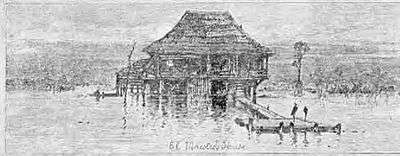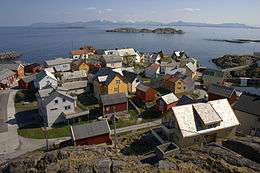Saint Malo, Louisiana

Saint Malo was a small fishing village that existed in southeast Louisiana on the shore of Lake Borgne, from the mid-18th century colonial period into the early 20th century, when it was destroyed by a hurricane. It was the first settlement of Filipinos in the United States.
Saint Malo was the first Filipino settlement in today's U.S. and quite possibly the first Asian settlement there, as well. It was established in 1763 by deserters from Spanish ships during the Manila Galleon trade, in what became St. Bernard Parish (then part of Spanish Louisiana), on the shore of Lake Borgne. Saint Malo persisted into the early 20th century, until it was destroyed by the New Orleans Hurricane of 1915.[1] The people who settled in the bayous were called Manilamen and later Tagalas. They governed themselves and kept their community's existence separate from mainstream society. The diet in the village was mainly fish.
Some of Saint Malo's fishermen were witness to the British invasion of Louisiana late in 1814, during the War of 1812, and may have joined the Baratarians under Jean Lafitte in defending New Orleans.
Etymology
The area of St. Malo is named after the leader of a group of maroons. In 1784 a group of enslaved Africans led by Jean Saint Malo escaped to a marshy area of Lake Borgne, with weapons obtained from free people of color and plantation slaves. Jean Saint Malo was captured by Spanish forces. On June 19, 1784, he was hanged in front of St. Louis Cathedral in what is now called Jackson Square, New Orleans.[2]
Location
St. Malo was on a waterway called Saint Malo Bayou, about 5 miles (8.0 km) east of the fishing village of Shell Beach.
Origin
The Saint Malo settlement was established, by some accounts, as early as 1763 by Filipinos who deserted from Spanish ships during the Manila Galleon trade.[3][4][5] (Other accounts suggest that the community was established sometime after 1812.)[6] Reasons for their desertion from the ships varied; however their desire to escape the Spanish brutalities is generally regarded as the main reason.[7] They settled in the marshlands of Louisiana where no Spaniards could reach them. The people who settled in the bayous were called Manilamen and later on Tagalas.[8] They governed themselves and kept their existence a secret from mainstream society for over a hundred years.[9]
It wasn't until journalist Lafcadio Hearn published an article in Harper's Weekly in 1883 that their existence was finally exposed to the American people. Hearn's article is the first-known published article about the Filipinos in the United States.[10]
Dwellings
Hearn was able to visit the village, and his account provided very detailed information regarding their dwellings. The Manilamen lived in small houses which were supported above the water by stilts.[1] The palmetto and woven cane did not have the durability to withstand the violent climate of the bayous. Much of the wood needed to build the houses had to be shipped from various parts of Louisiana, as wood strong enough to support dwellings could not be easily found in the swamps. Since many creatures of all kinds lived in the swamps, the dwellers found it necessary to improvise their houses. They had every window closed with wire netting to protect themselves from mosquitos and other insects and also had to be vigilant for reptiles and other animals abound in the swamps. There was no furniture, no table, no chair and no bed in any of the dwellings. What could have been considered as mattresses were filled with what Hearn called “dry Spanish-beard.” These were laid upon “tiers” of shelves faced against the walls. According to Hearn the fishermen slept at night “among barrels of flour and folded sails and smoked fish.”

Way of life
Diet
The diet in the village was mainly fish. They rarely ate rice, even though it is a staple food of Filipinos.
Religion
The predominant religion of the Manilamen was Roman Catholicism, although it was not known if a priest actually visited the settlement from nearby New Orleans to minister or perform any Christian rites and sacraments.
Government
The Manilamen paid no taxes and had no policemen. They had set their own rules and laws that all those living in the village were bound to obey. In case of disputes, it was usually left to the oldest man currently living in the settlement to mediate the situation. If a man refused a given verdict or likewise became a problem, he was jailed in what was called a “fish-car”, a makeshift jail cell. Due to the harsh conditions and lack of food, the offender would usually change his mind and obey any rule or decision. The village was never visited by any Louisiana government official or tax man even though it was within the jurisdiction of St. Bernard Parish.
Family
Rarely did women live in the village. In fact there were no women in the village during Hearn's visit. Those fishermen who did have families had them live in New Orleans or in other localities.[3] The reason for this can be attributed to the isolated and harsh conditions of the settlement. Since there were no Filipino women, the Manilamen often courted and married Cajun women, Indians, and others. Some of them enrolled their children in schools in New Orleans.
Whenever possible, if there were still the means of re-connecting with their families back in the Philippines, the Manilamen sent money to friends in Manila with the profits they made from fishing.
Role in the War of 1812
According to oral history and later cited by Filipino historians, the Manilamen took part in the Battle of New Orleans in 1815 during the War of 1812. These men signed up with the privateer Jean Lafitte to join the army of Major General Andrew Jackson.[6][7][11]
In late December 1814, a very large British army under the command of Major General Sir Edward Pakenham prepared to capture New Orleans, Louisiana. According to historian Marina Espina, the defending American force under Jackson consisted of “regular army troops, state militia, western sharpshooters, two regiments and pirates from the Delta Swamps.” It has long been suspected, but never confirmed, that many of these so-called pirates were the Manilamen. They were described as "Spanish fishermen" from the Lake Borgne area. Except for the Isleños, the only known Spanish-speaking fishermen living in the region at that time were the Manilamen.
Destruction of Saint Malo
The community was destroyed by the New Orleans Hurricane of 1915 and the survivors assimilated with New Orleanians.
Other Filipino settlements
Saint Malo was only one of the Filipino settlements in the Southern United States. The other southern Louisiana settlements were Manila Village on Barataria Bay, in the Mississippi River Delta by the Gulf of Mexico; Alombro Canal and Camp Dewey in Plaquemines Parish; and Leon Rojas, Bayou Cholas, and Bassa Bassa in Jefferson Parish.
Manila Village on Barataria Bay was considered to be the largest and most popular; Saint Malo, however, was the oldest. Houses in Manila Village were built on stilts on a 50-acre (200,000 m2) marshland; this community survived until 1965, when Hurricane Betsy destroyed it.[12][13] Part of the legacy of the Filipinos was the production of dried shrimp, known as "sea bob" from the French term "six barbe." Dried shrimp is still produced by the Cajuns of Louisiana.[13][14]
Some descendants of the original Filipino settlers continue to live in Louisiana today, as multiracial Americans.[15][16]
See also
- Manila Village, in Jefferson Parish, Louisiana
- Town of Jean Lafitte, in Jefferson Parish (History)
- Republic of the Philippines
- Dried shrimp
- Filipino Americans
- Lafcadio Hearn, 19th-century writer who penned the first-known published article about Filipino Americans
- List of fishing villages
References
- 1 2 "Manila Village". Smithsonian Asian Pacific American Program. Smithsonian Institution. 2008. Retrieved 13 February 2011.
- ↑ Nestor P. Enriquez. "Other Spirits of Saint Louis". Retrieved 15 February 2011.
- 1 2 "The Journey from Gold Mountain: The Asian American Experience" (PDF). Japanese American Citizens League. Retrieved 14 February 2011.
- ↑ "California Declares Filipino American History Month". San Francisco Business Times. 10 September 2009. Retrieved 14 February 2011.
- ↑ Pang, Valerie Ooka; Li-Rong Lilly Cheng (1998). Struggling to be heard: the unmet needs of Asian Pacific American children. SUNY Press. p. 287. ISBN 978-0-7914-3839-8. Retrieved 25 February 2012.
- 1 2 Rodel E. Rodis. "Filipinos in Louisiana". Global Nation. www.inq7.net. Retrieved 14 February 2011.
- 1 2 Cesar D. Candari. "Brief History of Filipino Immigrants: How I Came to America". Asian Journal. Retrieved 14 February 2011.
- ↑ "Watermarks: 'Manila-men' Sailors/Fishermen, U.S. American Orientalism, and Bayou St. Malo, Louisiana, a lecture on Tagala sailors by Kale Bantigue Fajardo Jan 12". Ateneo de Manila University. 10 January 2011. Retrieved 14 February 2011.
- ↑ Edgardo J. Angara (18 September 2005). "Filipinos in Louisiana". Manila Bulletin. Retrieved 15 February 2011.
- ↑ "Filipino Migration to the United States". Office of Multicultural Student Services. University of Hawaii. Retrieved 14 February 2011.
- ↑ Williams, Rudi (3 June 2005). "DoD's Personnel Chief Gives Asian-Pacific American History Lesson". American Forces Press Service. U.S. Department of Defense. Retrieved 26 August 2009.
- ↑ Keim, Barry D.; Robert A. Muller (2009). Hurricanes of the Gulf of Mexico. Louisiana State University Press. p. 85. ISBN 978-0-8071-3492-4. Retrieved 14 February 2011.
- 1 2 Rodel Rodis (25 October 2006). "A century of Filipinos in America". Philippine Daily Inquirer. Retrieved 14 February 2011.
- ↑ "Saint Malo, Oldest Filipino Settlement in USA?". Fil-Am Ako. 15 April 2010. Retrieved 14 February 2011.
- ↑ "Immigration". American Federation of Teachers. AFL-CIO. Retrieved 14 February 2011.
- ↑ Buenker, John D.; Lorman Ratner (2005). Multiculturalism in the United States: a comparative guide to acculturation and ethnicity. Westport, Connecticut: Greenwood Publishing Group. p. 120. ISBN 978-0-313-32404-8. Retrieved 14 February 2011.
Further reading
Espina, Marina Estrella (1988). Filipinos in Louisiana. A.F. Laborde. p. 100. Retrieved 25 February 2012.
External links
| Wikimedia Commons has media related to Saint Malo, Louisiana. |
Coordinates: 29°52′41″N 89°35′49″W / 29.87806°N 89.59694°W

